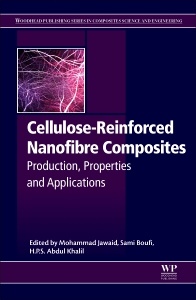Cellulose-Reinforced Nanofibre Composites Production, Properties and Applications Woodhead Publishing Series in Composites Science and Engineering Series
Coordonnateurs : Jawaid Mohammad, Boufi Sami, H.P.S. Abdul Khalil

Cellulose-Reinforced Nanofibre Composites: Production, Properties and Applications presents recent developments in, and applications of, nanocellulose as reinforcement in composite and nanocomposite materials.
Written by leading experts, the book covers properties and applications of nanocellulose, including the production of nanocellulose from different biomass resources, the usefulness of nanocellulose as a reinforcement for polymer and paper, and major challenges for successful scale-up production in the future. The chapters draw on cutting-edge research on the use of nanosized cellulose reinforcements in polymer composites that result in advanced material characteristics and significant enhancements in physical, mechanical and thermal properties.
The book presents an up-to-date review of the major innovations in the field of nanocellulose and provides a reference material for future research in biomass based composite materials, which is timely due to the sustainable, recyclable and eco-friendly demand for highly innovative materials made from biomass.
This book is an ideal source of information for scientific and industrial researchers working in materials science.
1. Nanofibrillar Cellulose in Thermoset Polymer Composite 2. Hybrid Montmorillonite/Cellulose Nanowhiskers Reinforced Polylactic Acid Nanocomposites: A Comparative Study Based on Formulation Design 3. Bionanomaterials from agricultural wastes and their applications 4. Recent advances in cellulosic nanocomposites 5. Challenges in Design of Nanocellulose and its composites for different applications 6. Nanofibrillar Cellulose from agricultural biomass residues 7. Nanofibrillated cellulose as strength additive for paper 8. Nanocellulose in Functional Packaging 9. Application of Nanocrystalline cellulose: processing and applications in biomedical 10. Nanowhiskers from oil palm biomass 11. Cellulose nanocrystals: preparation Methods and applications 12. Nanocellulose as new adsorbent for environmental remediation 13. Nanofibrillar Cellulose in Nanocomposites 14. Bacterial cellulose: Preparation and Characterization 15. Preparation of Bionanocomposites and bionanomaterials from agricultural wastes 16. Cellulose nanocrystals-based nanocomposites 17. Green nanocomposites from cellulose nanowhiskers and Jathropa oil-based polyurethane 18. Key issues in reinforcement involving nanocellulose 19. Nanocellulose as a template for the production of advanced nanostructured material 20. Cellulose Nanomaterials as Additives for Cementitious Materials 21. Cellulose Nanocomposites: Opportunities and Challenges
Dr. Mohammad Jawaid is currently affiliated with the Department of Chemical and Petroleum Engineering at United Arab Emirates University. Previously he was a senior fellow (professor) in the Laboratory of Biocomposites Technology at the Institute of Tropical Forestry and Forest Products (INTROP), Universiti Putra Malaysia. He is an eminent scientist with more than twenty years of teaching, and research experience in composite materials. His research interests include hybrid reinforced/filled polymer composites, and advanced materials such as graphene/
nanoclay/fire retardant, lignocellulosic reinforced/filled polymer composites, and the modification and treatment of lignocellulosic fibres and solid wood, and nanocomposites and nanocellulose fibres.
Sami Boufi is a Professor at the Chemistry Department of the Faculty of Sciences of Sfax, Tunisia, and a Researcher in the LMSE (Laboratory of Material Sciences and Environment). His research activities focus on nanocellulose and nanoparticles from biopolymers, composites and nanocomposites based on lignocellulosic filler and nanocellulose, and heterogeneous polymerization (emulsion, miniemulsion and suspension). Prof. Boufi has authored or co-authored over 130 papers in peer reviewed journals, and 3 book chapters.
Abdul Khalil H.P.S. is a Senior Professor in biomass and biocomposites at the School of Industrial Technology, Universiti Sains Malaysia, Penang, Malaysia. His specialisms include biocomposites technology, hybrid composites, nano-based composites, and fibre science (natural and man-made fibre). Prof. Abdul Khalil is a Fellow of the Institute of Materials, Minerals and Mining (FIMMM), in the United Kingdom. He is a member of the America Chemical Society and a member of Wood Science and Technology. He has been appointed to the editorial board of more than 5 Scopus/ISI listed journals. Prof. Abdul Khalil has a total of 180 publications to his name, and has published 3 academic books and
- Gathers together a broad spectrum of research on nanocellulose, with emphasis on the outstanding reinforcing potential when nanocellulose is included into a polymer matrix or as an additive to paper
- Demonstrates systematic approaches and investigations from processing, design, characterization and applications of nanocellulose
- Presents a useful reference and technical guide for nanocomposite materials R&D sectors, university academics and postgraduate students (Masters and PhD) and industrialists working in material commercialization
Date de parution : 06-2017
Ouvrage de 548 p.
15x22.8 cm
Thème de Cellulose-Reinforced Nanofibre Composites :
Mots-clés :
Acid hydrolysis; Additive; Adsorption; Agricultural waste; Agricultural wastes; Antimicrobial agents; Applications; Bacterial cellulose; Bacterial cellulose (BC); Bacterial strains; Biobased polyurethane; Biocompatibility; Biodegradability; Biomass; Biomaterials; Biomedical application; Biomineralization; Bionanocomposites; Bionanomaterial; Bionanomaterials; CNC; Cellulose; Cellulose chemistry; Cellulose nanocomposite; Cellulose nanocrystals; Cellulose nanocrystals (CNC); Cellulose nanofiber; Cellulose nanofibers; Cellulose nanofibrils; Cellulose nanomaterials; Cellulose nanowhiskers; Cellulose whiskers; Cellulose-cement composite; Cement; Chemical swelling; Composite; Composites; Decision making; Design model; Designing; Drainability; Dyes; Enzyme hydrolysis; Functionalization; Green bionanocomposites; Green nanocomposites; Heavy metal; High yield; Hydration; Jatropha curcas L; Jatropha oil; Mechanical properties; Mechanical property; Microcrystalline cellulose; Microfibrillated cellulose (MFC); Montmorillonite; Morphological properties; Nanocellulose; Nanocellulose nanocomposites; Nanocellulosic modification; Nanocomposite; Nanocomposites; Nanocrystalline cellulose; Nanofibers; Nanofibrillar; Nanofibrillated; Nanofibrillated cellulose (NFC); Nanomaterial; Nanoparticles; Natural composites; Oil; Oil palm empty fruit bunch; Olive stone flour; Optic properties; Organic pollutants; PP; PVC; Packaging; Paper; Papermaking; Polylactic acid; Reinforcement; Renewability; Rheological properties; Rheology; Surfactants; Synthesis of cellulosic nanofibers; Techniques for characterizations; Template; Tensile properties; Thermoset; Transmission electron microscopy; Waste management; Water treatment; Ânanoreinforcement



